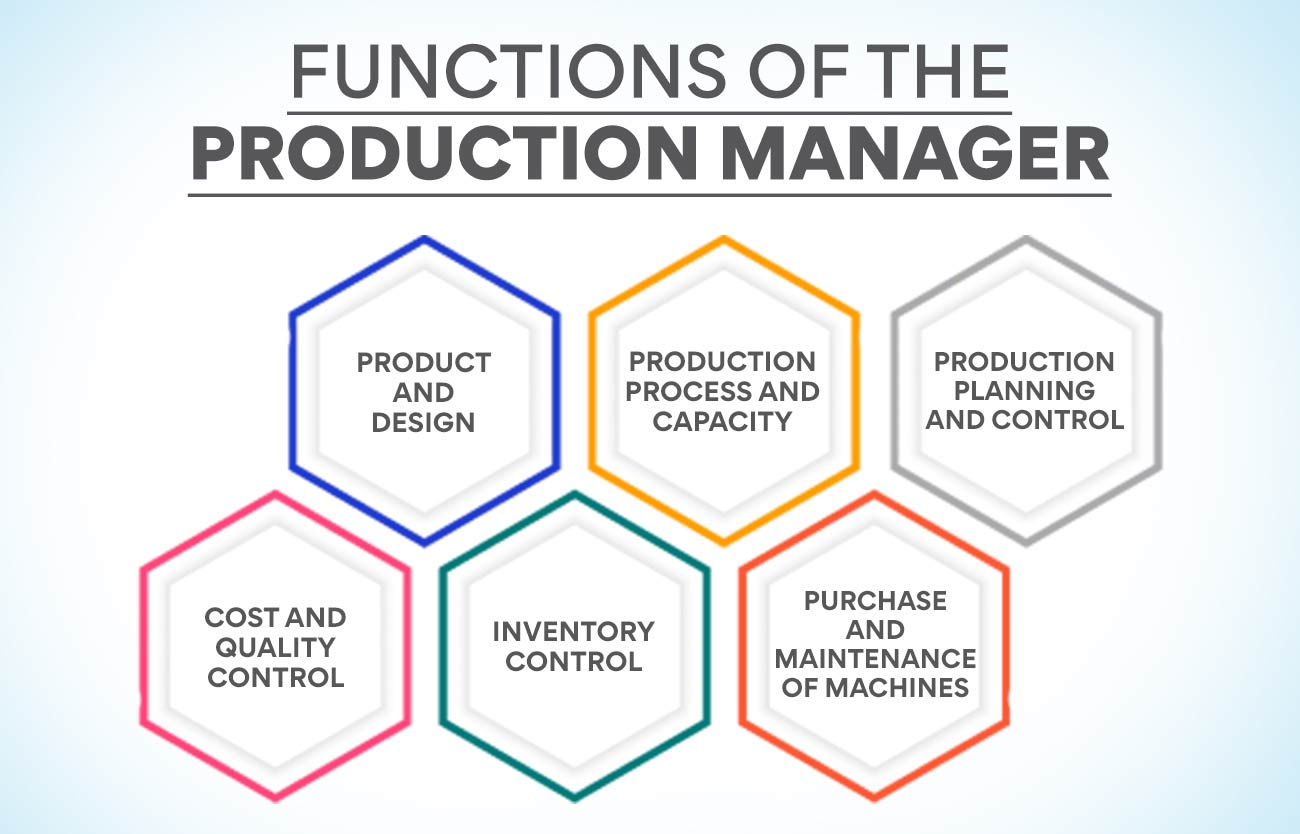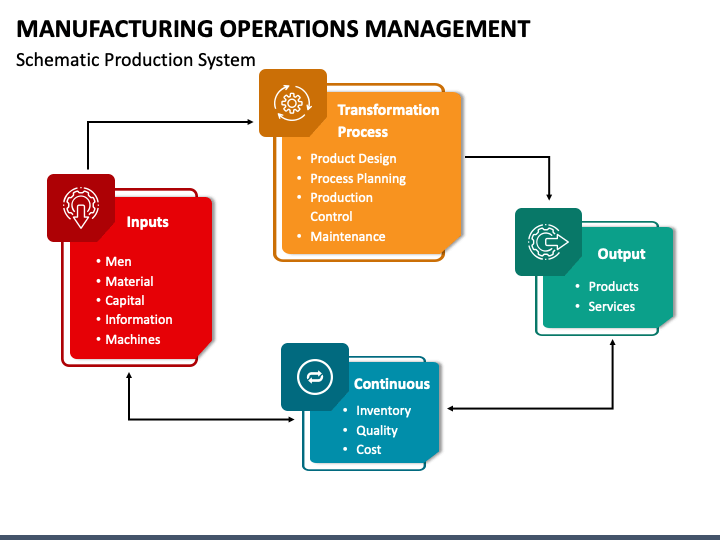Complete Guide on Productions and Operations Management
Table of Contents

- jaro education
- 22, April 2024
- 10:00 am
Introduction
Production and operations management is all about creating and delivering the right products with the expected quality and quantity within the allotted time and cost. Effective operations and production management process include efficient workflows and informed decision-making. If a company manufactures and performs operations within a discrete system, it will leave the potential risk of product failure and other anomalies. Thus, every business needs well-planned production and operations management.
So, in this blog, you will discover the objective of production and operations management and how it can help you streamline your business activities.
What is Production and Operations Management?
Production and operations management is the process of converting resources into products and services. Production management incorporates the activities of developing the products, whereas operations management includes the activities of both product manufacturing and delivery. Both of these management strategies must be implemented with well-defined plans and policies to ensure the best results.
The scope of production and operations management includes product design, production and planning control, process design, material handling, quality control, and materials and maintenance management.
Importance of Production and Operations Management for a Business
Production management drives business growth and success and has other important roles within an organisation. These are –
- It reduces production costs and maximises resource utilisation. For these, an organisation needs to make a clear strategic plan. A clear strategic plan reduces production costs and time and enhances resource utilisation.
- Production management helps organisations to increase their competitiveness in the market. It also improves process efficiency and product quality.
- It helps organisations to understand the customers’ demands. As a result, they can produce the right quality of the product in the right quantity. Hence, it mitigates the chance of product failure.
Besides production management, businesses also can’t stand without effective operations management. So, the importance of operations management for a firm includes the following –
- It enhances communication and collaboration between different levels of people like operation managers, employees, customers and stakeholders. So, it ensures consistency of communication within the organisation.
- Operations management ensures the quality of operations through the latest technologies and trends. Operations managers use Six Sigma to improve quality, reduce errors and increase the feasibility of the operations.
- In this era of digital transformations, all the operations management platforms provide automated solutions for operational workflows. Thus, it reduces time consumption and monotonous tasks.

*edureka.co
Objectives of Production and Operations Management
The objectives of production management are –
Right Quantity
By producing the right number of products, the factories meet their customers’ demands, fulfil their business goals, and make greater ROI. If they produce an excessive number of products than the actual demand, it will block up the capital. Alternatively, if they produce less, it will lead to a shortage in the market and failure to meet the demand, leaving the customer dissatisfied. Thus, every organisation should find a middle ground between demand and production.
Right Quality
Product quality is a key factor for any business. Customer demand is the basis for determining product quality. So, depending on the demand and expectations of the customers, companies need to create differe/nt products. At the same time, quality also depends upon the products’ costs, technical functionalities and client satisfaction. So, ensuring this quality status is a clear objective of product management.
Time
Another crucial objective of production management is the delivery timeline. If the production department fails to meet the timeline, it will leave a negative impression on the users. Thus, the production team has to make clear strategies to achieve their delivery goals.
Manufacturing Cost
The production departments make their budget estimation before the actual manufacturing stage. First, they build the products at the predetermined cost. Later, this strategy helps to reduce the variation between the estimated and actual costs.
The objectives of operations management are as –
Productivity and Efficiency Improvement
Productivity and efficiency are the primary objectives for the operations management workflows. The operations managers boost productivity and efficiency by eliminating bottlenecks, tweaking resource allocation and streamlining workflows. It also includes cost reduction, output enhancement and minimising waste. By doing these, the organisations deliver their products and services on time, ensure customer satisfaction and improve their competitiveness.
Supply Chain Management
Supply chain management has become a key objective in today’s interconnected business ecosystem. The operations managers govern every activity of supply chain management. They streamline the process by optimising inventory levels, reducing supply chain risk, ensuring on-time transportation and supplier relationship management. Effective management strategies for supply chain help organisations to achieve operational flexibility and customer satisfaction.
Strategic Alignment
It’s essential to have an alignment of operational strategies with the entire strategic goal of the organisation. Thus, operations managers work with the people at the top management level to understand the organisation’s vision, mission and value. They ensure that the operational decisions meet these factors. Strategic alignment helps the companies to utilise the resources more efficiently and drive new opportunities.

Top Tools Used for Production and Operations Management
Here, we have enlisted the tools for production and operations management –
ClickUp
ClickUp is a project management and collaboration tool for product and development teams of businesses of all shapes and sizes. This platform provides a fully customised solution for effectively handling the product development process. The simple drag-and-drop functionalities and no-code automation help the users to speed up the development process. It guides in building precise product roadmaps, product backlog management, product launch plans, Gantt charts, Whiteboards, Mind Maps and more. Additionally, it has 1000+ templates for product strategy, product management, marketing, software development, etc. All these features help the companies to maintain product lifecycle, resources, deadlines and teams in a centralised environment.
Jira
Atlassian’s Jira promotes agile methodology to create effective product life cycle management. Specifically, this tool becomes helpful for the software development life cycle. The platform incorporates features like Scrum and Kanban boards, roadmap creation for the product strategy, workflow automation, team performance analysis, tracking and monitoring project progress, and more. According to Atlassian, Jira has become the #1 platform for software development by the agile teams. Now, it’s trusted by more than 100K teams across the globe for planning, designing and deploying software. Furthermore, it has integrations with a plethora of productivity tools, DevOps tools and other platforms.
ProductPlan
ProductPlan is an excellent product roadmap-building platform for successful production management. It helps companies build strategic roadmaps that are well-aligned with customers’ needs and preferences. The platform comes with features like portfolio roadmaps, flexible layouts for the roadmaps, roadmap standardisations, custom views, Kanban-style roadmap creation and more. It automates the data flow between several tools. Furthermore, it synchronises information between the production management platform and the product roadmap.
monday.com
monday.com is a cloud-based collaboration, communication, project tracking and task management platform. This platform was crowned as a leader for collaborative work management in Gartner Magic Quadrant, 2023. The customisable project boards of this platform manage tasks and design unique workflows with automation. It has automated task and project approvals, pre-built workflow automation templates, document management, order visualisations, marketing strategy, order management and more. Moreover, their in-house data engine makes complex business workflows faster and more flexible. To get a more optimised workflow, one can integrate it with Slack, Trello, Dropbox, etc.
Asana
Asana is another collaboration and project management platform that helps the team work in a centralised ecosystem during the project lifecycle. It offers customised dashboards, templates, automated workflows, campaign management, Gantt charts, Kanban boards and more. Now, Asana Intelligence makes the workflows more scalable, transparent and impactful. Moreover, it employs enterprise-grade security to protect companies’ data and has 300+ integrations for making the workflows more simplified. According to a recent study, Asana has become a leader in Worldwide Collaborative Work Management Vendor Assessment in IDC MarketScape.
SAP Supply Chain Management
SAP Supply Chain Management guides organisations in streamlining and managing their supply chain processes. The platform includes features like automated warehouse management, global transportation management, procurement and supplier management, resource management, predictive analysis, etc. Also, it allows marketers to collaborate with their global supply partners in real time. In this way, they can mitigate the risks of lower supply chain disturbances and demand volatility, improve supply quality and reduce costs.
Emerging Trends of Production and Operations Management
The emerging trends of production management are –
Artificial Intelligence (AI)
The most important benefit of AI is its outstanding ability to analyse massive amounts of data. The AI algorithms instantly scan and process data to identify trends and patterns. These trends and patterns help the producers and manufacturers examine the performance of production processes. Not only can these AI tools help identify the bottlenecks and defects within the process, but they can also help companies identify and understand quality issues within the production process faster than before and find a resolution.
Additionally, the producers can use AI to build predictive maintenance processes and systems, identify safety concerns in the workplace and streamline the supply chain management.
Robotics and Automation
Robotics and automation have become emerging trends for production management in the last decade. With robotics technology, organisations can streamline manual and repetitive tasks, which then eliminates defects, improves product quality and enhances the accuracy of those tasks. Moreover, companies can integrate big data analytics and Industrial Internet of Things (IIoT) sensors with robotics to boost the responsiveness and flexibility of the production environment. So, we can say that robotic process automation helps to implement a robust production strategy. Side by side, it eliminates the hazardous tasks of production like – welding, material handling and assembly.
Digitalisation and Industry 4.0
With cutting-edge technological revolutions, digitalisation has become an impactful trend in the manufacturing sector. It makes the businesses more optimised, reduces cost and improves quality.
Industry 4.0 is the cause of digitalisation — the fourth industrial revolution. It’s the current phase of the digital transformation within the manufacturing industry. It includes other modern technologies such as cloud computing, AI and Internet of Things (IoT).
Industry 4.0 assists manufacturers in collecting real-time data, analysing large amounts of data, and gaining insightful information on their product management operations. Moreover, this trend helps companies maintain their equipment, conduct smooth communication between that equipment and use cloud storage. In this way, they promote a more agile and flexible production environment.
3D Printing
3D printing has become a popular trend for designing and developing complex components and modules for products. This has changed the methods of designing, prototyping and manufacturing products. Additionally, 3D printing helps to simplify complex geometries and produces them in a single step, reducing production costs and time. Remember that 3D printing is also called additive manufacturing.
This trend has become handy within high-tech industries like aerospace, healthcare and automotive, where making complicated parts, is mandatory.
Digital Twins
Digital twins have become another popular trend for production management. A digital twin is a virtual replication of a physical object, product or system. It includes sensors to provide real-time information about the functionalities of the physical product. These sensors’ data help the digital twin to detect potential issues, faults and anomalies in a system or product. Moreover, it can boost forecasting efforts and provide information to improve the production process.
Smart industries use digital twins to monitor and streamline the performance of machines, tools and manufacturing processes. Also, the manufacturers use this trend to simulate test configurations and scenarios.
Now, let’s deep dive into the trends of operations management –
Agility
Due to the changes in customers’ preferences, the volatility of the global economy, and maintaining market share, organisations are adopting new trends like agility in their operation management processes. Agility supports quick adoption of market changes (both internally and externally) and faster response to customers’ demands. In this way, the agile approach empowers organisations to implement a cost-effective solution for maintaining product quality, transparency, accountability, collaboration and boosting production. Thus, agility supports the growth and consistency of staying in the race for a company.
Lean Practices
Another significant trend is lean practices. The production units adopt lean practices to replace the lengthy traditional business methods. Most of the time, they need to conduct mass production for mass sales targets. As a result, the overall process becomes costly. However, with lean practices, the factories can produce the goods and services as per the order confirmation from the customers. Thus, this trend helps companies to conduct their operations swiftly and flexibly. Also, it cuts excessive costs and waste matters in operations management.
Real-Time Communication and Collaboration
Real-time communication is a crucial factor for revamping operation management within a company. Communication is essential to maintain the consistency of the workflows between all the staff, departments and stakeholders of a company. It ensures the smooth functionality of the overall system.
So, now organisations integrate advanced communication systems like emails, social media platforms, live chat, live video calls, phone calls and more. Additionally, they can use several project management and collaboration tools like — Jira, Trello, Slack, etc. These tools provide full potential for conducting remote work, as well as real-time collaboration and communication. Thus, this trend helps the business to promote flexibility and consistency within the operations management.
Internal Audits
Internal audits have become another significant trend for detecting and rectifying issues within operational procedures. Regular internal audits eliminate the issues from the business operations at the primary stages and save the organisations from potential losses. Thus, internal audits lead the operations management team towards self-accountability and consistent refinement. As a result, they have control over the business operations and mitigate the risks of potential losses.
Customer Centricity
Customer-centricity is an ongoing trend in operations management in every industry. Businesses must maintain strong relationships with their customers and understand their requirements, interests and pain points. By implementing these strategies, they stay ahead of the market competition.
However, companies that don’t follow cust omer-centric approaches are at risk of losing their competitive edge. Thus, every business should continuously monitor their customers’ preferences and needs to meet their expectations. Also, it’s essential to gather feedback from them to make further progress in the operational workflows and improve user experience.
Challenges for Implementing Production and Operations Management
Here are some challenges of production and operations management that companies need to work on –
Shortage of Labours
The labour shortage is a common problem within every industry. To match the demand-supply chain, companies need skilled professionals, but the lack of them is a serious concern. It hampers the whole business flow, resulting in revenue losses for brands. The obvious way to deal with this is upskilling. Through skill improvement programs, companies can deal with such situations.
Equipment Downtime
Most businesses like warehouses, production facilities, distribution centres, etc. depend upon material handling equipment (MHE). The movable parts of these machines can break down. As a result, it causes unplanned and sudden equipment downtime. So, again it leads to longer time consumption and logistic delays.
Thus, businesses should emphasise predictive maintenance of equipment like regular inspections, lubrication and replacing damaged parts. It helps to reduce the costs of potential damages and the rate of equipment downtime.
Delays or Long Lead Time
It’s a common expectation of a buyer to get on-time delivery from a business. But there are enough reasons, such as supply of raw materials, weather issues, warehouse errors, transport issues, equipment downtime and untrustworthy vendors, which cause delays.
To avoid these situations, businesses should improve communication and coordination, source different vendors, reduce agreement delays, automate the supply chain, etc.
Conclusion
Production and operations management streamlines and simplifies organisational workflows. Effective product management ensures clear product planning and development, maintains product quality and reduces cost. Operations management, on the other hand, transforms raw materials into goods/services.
To learn about production and operations management, you may enrol in courses like Online MBA Degree Programme – Symbiosis School For Online And Digital Learning (SSODL). Opting for a course like this helps you understand the process of optimising your business process and resources, which, in turn leads to an increase in revenue generation. For more details, you can always contact Jaro Education.
Frequently Asked Questions
The impactful factors for choosing a production facility are – location selection, infrastructure, labour laws, business landscape, real estate framework, political stability and land acquisition process.
The Business Process Maturity Model (BPMM) examines and categorises the maturity level of the business processes of a company.
By implementing effective planning, processing, strategy making, testing and training, companies can ensure the standard of their products’ quality.
The companies control their production based on their budget and customers’ demand. Two methods are applied here. In one case, the companies keep the production in-house and maintain it. Another option is to outsource the whole operation to a third party through bulk orders and then control the production.
Companies use the latest technologies and trends for production and operations management, such as automation, robotics, digital twins, IoT, AI, machine learning and more. By using these trends, they can improve their efficiency.








